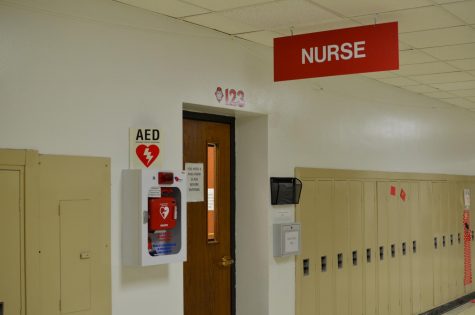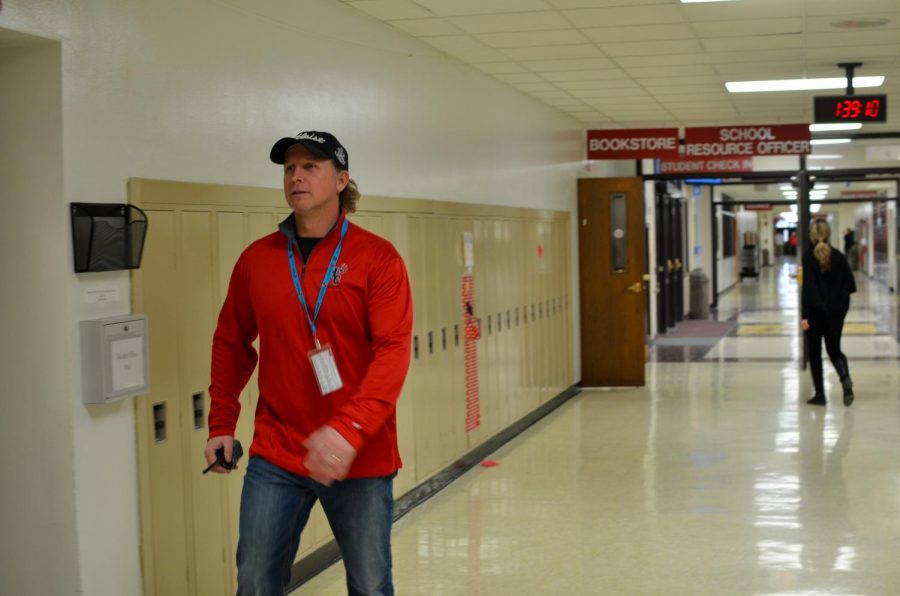Protocol during school crises
Hall monitors such as Mr. Simpson carry walkie-talkies around at all times in case of a school crisis.
Sitting in class, the day seems to drag on as you stare at the ticking clock. Suddenly, what is normally a slow-paced class period turns into a frantic experience as a student drops to the floor. Classmates look at each other in shock, the teacher tries to react calmly and quickly, and everyone wonders what comes next.
In light of recent incidents, in which multiple students have fainted or experienced seizures throughout the school day, many students and staff members are reevaluating the current protocol for these situations.
Just in the past week, three students have had these types of experiences, leaving staff members to have to react quickly and efficiently.
“[During an emergency] the Health Office is usually notified over the walkie talkie system, and one nurse brings the emergency bag to the site of the emergency. The other nurse stays and covers the Health Office,” said Ms. Melissa Geibel, school nurse. “The nurse at the emergency communicates with the Health Office to get appropriate student health information, make appropriate health decisions, and render first aid.”
Although it is unlikely for students to have an emergency like this in class, news always spreads fast, and many students have heard of situations in which their peers are in need of medical assistance.

Defibrillators, fire extinguishers, police call boxes, and fire department call boxes line the hallways of the school in case of an emergency.
“I’ve never experienced any emergencies in any of my classes, but I have heard about other students fainting or passing out in other classes,” said Nick Lynch, sophomore.
It is not only health-related emergencies that occur during school hours. Devils’ Advocate’s own Marelena Halikias, junior, experienced a mechanical error in an elevator that resulted in the school having to respond promptly and effectively.
“I was in the elevator because I had foot surgery and that week the power was cutting in and out at school. All of the sudden, the lights went out, I heard a strange sound, and the elevator shook a bit,” Halikias said. “The elevator was stuck in between the first and second floor, and it took about a half hour before I finally got out.”
Although these incidents don’t occur very often, they still come as a shock when they do happen, leaving many to wonder how the school can better prepare for these occurrences.
“Every time a crisis occurs, the staff involved debrief to discuss what went well and what can be improved upon. This helps us streamline procedures so the next emergency goes smoother,” Ms. Geibel said.
Even if you are unprepared for emergency situations like these, Ms. Geibel reminds us that it is important to stay calm and remember that everyone can help in some way or another.
“Every team member’s job is important, from the school nurse, to the school resource officer, to the student supervisor who brings the wheelchair,” Ms. Geibel said.
If you do find yourself in a situation in which a classmate faints or passes out during a class, it is recommended that students notify a staff member and school nurse immediately.

Michalea Halikias is a senior who can often be found shopping online, listening to music, or hanging out with her friends. She loves watching Master Chef,...

Samantha Moriarty is a junior who can most likely be found on the soccer field or on the couch. When she isn’t waking up extremely early to fight for...

Marelena Halikias is a senior photographer for Devils' Advocate. She can commonly be found crying over reruns of The Joy of Painting, offering to sell...













